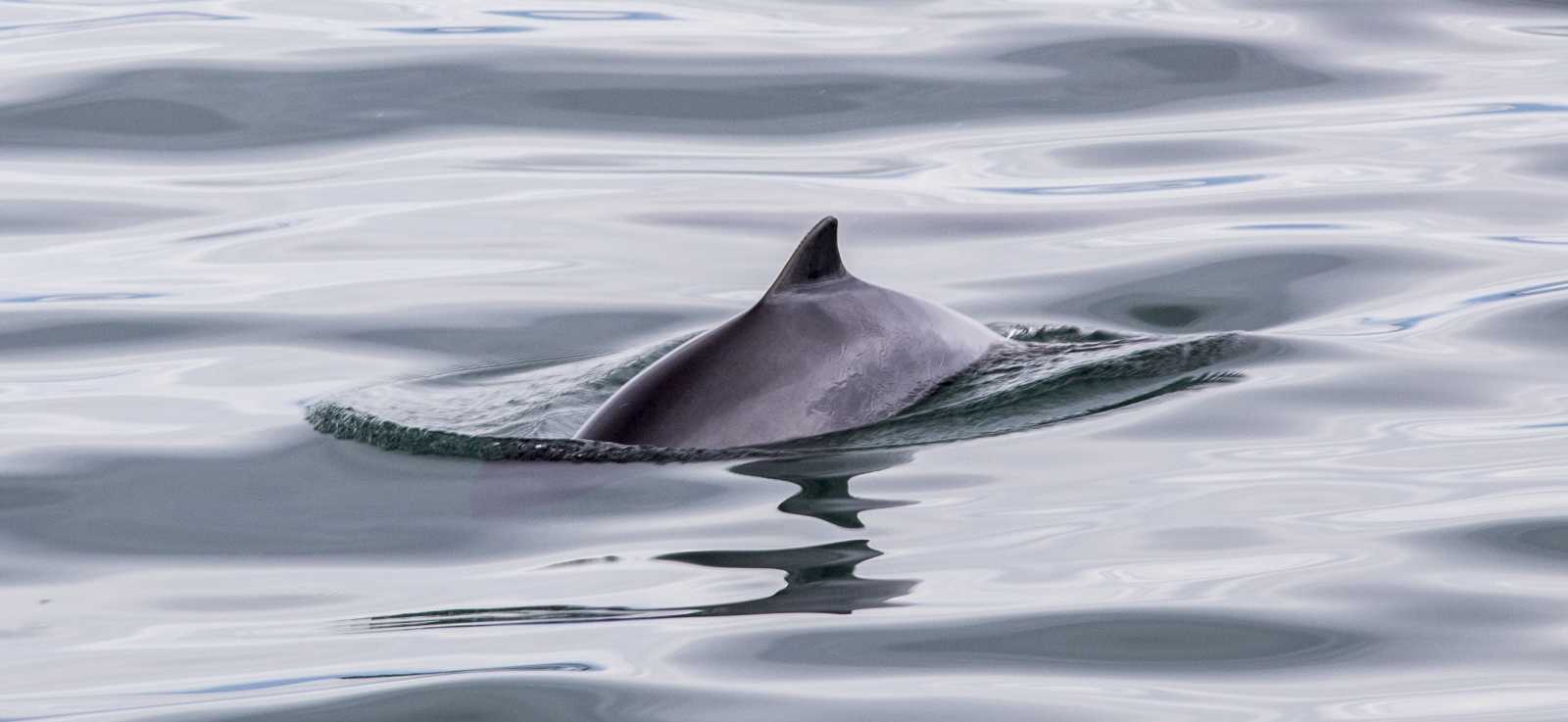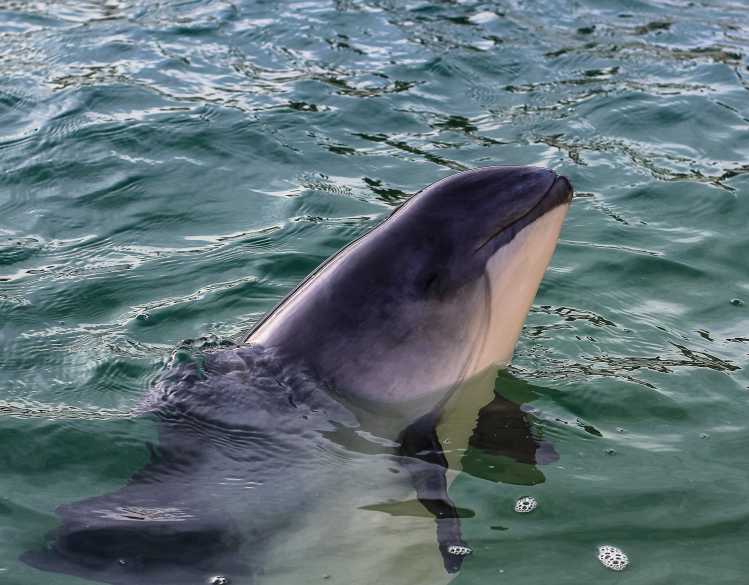
Harbor Porpoise
Phocoena phocoena
Learn More About Porpoises
While harbor porpoises and dolphins are both members of the toothed-whale family, they are distinctly different species. Harbor porpoises have a short, rounded face and beak, spade-shaped teeth and a triangular dorsal fin.
Harbor porpoises are charcoal gray on their back with light gray or white sides and underbelly. Females are slightly larger as they can weigh in at 168 pounds and reach about 6 feet in length. Males typically weigh about 134 pounds and can reach just over 5 feet in length. The average life span for both male and female harbor porpoises is 24 years.

The greatest threats to marine mammals are caused by people, but we can also be their greatest champions.
Sign up for email from The Marine Mammal Center to stay updated on how you can be an advocate and champion for marine mammals like harbor porpoises.
Harbor Porpoise Research at The Marine Mammal Center
Harbor porpoises have returned to San Francisco Bay after an absence of approximately 65 years. The Center's Cetacean Field Research Team is conducting a multi-year assessment to document this population’s abundance and distribution, as well as to examine their social behavior and calving success.
{"image":"\/Animals\/Wild\/Harbor porpoise\/cropped-images\/two-harbor-porpoises-203-2-599-467-1705601520.jpg","alt":"two harbor porpoises mating","title":"Sexual Behavior and Anatomy in Porpoises","link_url":"https:\/\/www.marinemammalcenter.org\/publications\/sexual-behavior-and-anatomy-in-porpoises","label":"Research Paper","type":"publication"}

{"image":"\/Animals\/Wild\/Harbor porpoise\/cropped-images\/harbor-porpoises-aerial-view-badge-by-marc-webber-c-the-marine-mammal-center-0-88-1280-999-1618509985.jpg","alt":"Harbor porpoises seen from above","title":"Coevolution of Asymmetric and Spiraled Genitalia with Unique Mating Behavior","link_url":"https:\/\/www.marinemammalcenter.org\/publications\/coevolution-of-asymmetric-and-spiraled-genitalia-with-unique-mating-behavior","label":"Research Paper","type":"publication"}

Coevolution of Asymmetric and Spiraled Genitalia with Unique Mating Behavior
Read More{"image":"\/Animals\/Wild\/Harbor porpoise\/harbor-porpoise-shutterstock-2.jpg","alt":"harbor porpoise","title":"Harbor Porpoises Catching and Handling Large Fish","link_url":"https:\/\/www.marinemammalcenter.org\/publications\/harbor-porpoises-catching-and-handling-large-fish","label":"Research Paper","type":"publication"}

{"image":"\/Animals\/Wild\/Harbor porpoise\/cropped-images\/harbor-porpoise-by-bill-keener-c-the-marine-mammal-center-309-73-1207-943-1610670087.jpg","alt":"Harbor porpoise surfacing in the water","title":"The Sex Life of Harbor Porpoises: Lateralized and Aerial Behavior","link_url":"https:\/\/www.marinemammalcenter.org\/publications\/the-sex-life-of-harbor-porpoises-lateralized-and-aerial-behavior","label":"Research Paper","type":"publication"}

{"image":"\/Animals\/Wild\/Harbor porpoise\/cropped-images\/harbor-porpoises-foraging-by-marc-webber-c-the-marine-mammal-center-4-0-1276-996-1618438446.jpg","alt":"harbor porpoises eating a large fish","title":"Prey-Related Suffocation in Harbor Porpoises","link_url":"https:\/\/www.marinemammalcenter.org\/publications\/prey-related-suffocation-in-harbor-porpoises","label":"Research Paper","type":"publication"}

Habitat & Population Status
The harbor porpoise is a coastal species often found in harbors, bays and estuaries of northern temperate and subarctic waters ranging from Monterey Bay to the northern Sea of Japan. These animals can be seen off the coast of California year-round and researchers consistently spot harbor porpoises swimming underneath the Golden Gate Bridge in San Francisco.
While there are thousands of harbor porpoises, many geographical populations are much smaller than they were in the past. For example, harbor porpoises were frequently seen in San Francisco Bay until the 1930s when they disappeared for almost 60 years.
It’s believed that harbor porpoises relocated during that time due to World War II and the use of submarine nets in San Francisco Bay to keep enemy boats away, along with an increase in environmental contaminants from industrialization. However, in the 1990s, following 20 years of restoration thanks to the Clean Air and Water Act, harbor porpoises began reappearing in San Francisco Bay.
Today, harbor porpoises around the world face many threats, such as entanglement in commercial fishing gear (e.g. bottom-set gillnets, trawls and herring weirs) as well as underwater noise pollution that interferes with their communication.

Breeding & Behavior
Female harbor porpoises reach maturity between 3 to 4 years old, after which they can become pregnant each year for several years in a row. Gestation typically begins in the late spring or early summer and lasts up to 11 months, resulting in most calves being born between May and July. These newborn harbor porpoises stay with their mother to nurse for about eight to 12 months.
The harbor porpoise is a shy and elusive animal, unlike their dolphin cousins, that is known to be solitary or travel in small pods of two to five individuals. However, little is known about harbor porpoises’ social affiliations and interactions.
This species usually feeds individually on schooling fish such as herring, capelin, sprat and silver hake, and will occasionally eat squid and octopus while traveling many miles per day. A harbor porpoise’s natural predators include large sharks and orcas.
Learn About Harbor Porpoise Mating in the "Funnel of Love"
Want to know the best place in the entire world to see harbor porpoises mating in the wild? Stand on the Golden Gate Bridge and look down! From 220 feet above the water, you will have an excellent vantage point and will not be interfering with the porpoises’ natural behaviors.
The bridge spans the narrow Golden Gate, a one-mile-wide strait separating the Pacific Ocean from the San Francisco Bay. As harbor porpoises pass between these two large bodies of water to feed, they are concentrated in the deep channel directly beneath the bridge. As the harbor porpoises swim by under the bridge (often in small groups of three to five at a time) mating attempts and other social activities increase dramatically. This area is affectionately known as the “Funnel of Love” by our experts.















